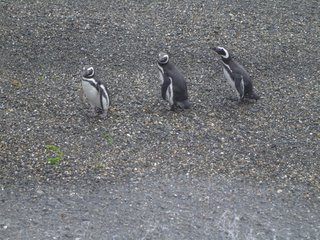Standing at the edge of the world
Ushuaia, Argentina, bills itself as the southernmost city in the world. It is virtually an island within an island, as it sits at the southern tip of Tierra del Fuego, trapped between the Andes Mountains and the sea. The Pan-American highway ends (or begins) here, at the edge of the South American continent, just 600-700 miles from Antarctica. And if one were to set sail east or west in a boat from Ushuaia, you could travel all the way around the globe and not hit another piece of land until you returned to your starting point.
In fact, when we were on a plane to Ushuaia, the man sitting next to Lisa asked her, "Are you going to Antarctica?" (The city is the main port for Antarctic cruise ships.) Truly, there are not many places in the world where one would be asked that question.
Lisa and I arrived in Argentina when it was late springtime in the southern hemisphere. In Buenos Aires, the temperature was in the 80’s, flowers were blooming, and people walked the streets in shirtsleeves. In Ushuaia, it was a good 30 degrees cooler, with a chilly wind blowing down from newly fallen snow in the Andes.
Here is a picture of Ushuaia:

The writer Bruce Chatwin, whom I also quoted in the previous post, was here in the mid-1970’s, before tourism changed the local economy and before cruise ships began to leave regularly from here for Antarctica. This is how he described Ushuaia in his book, In Patagonia:
Mornings in Ushuaia began in flat calm. Across the Beagle Channel you saw the jagged outline of Hoste Island opposite and the Murray Narrows, leading down to the Horn archipelago. By mid-day the water was boiling and slavering and the far shore blocked by a wall of vapor.On another day he wrote:
It was drizzling. Snow smears came down close to the shore. It was high summer. Behind the settlement the trees disappeared in the clouds.While in Ushuaia, we visited Tierra del Fuego National Park and cruised the Beagle Channel. During our afternoon boat trip there, one of the more interesting stops was at an island inhabited by penguins. Here is a photo of three of them strolling along the beach.

As an interesting aside, the Beagle Channel was named for the ship that carried Charles Darwin on his famous voyage. The HMS Beagle came through here in the early 1800’s and the crew interacted with the local Yamana Indians before continuing on up the west coast of South America. Hence, this lonely settlement so far from the rest of the world played a bit part in Darwin’s observations that led to his theory of evolution.
0 Comments:
Post a Comment
<< Home